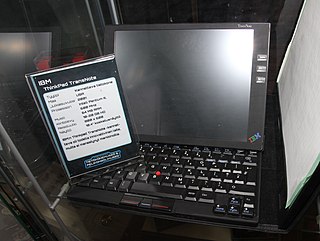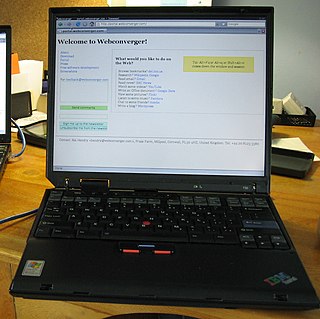
The Intel 486, officially named i486 and also known as 80486, is a microprocessor. It is a higher-performance follow-up to the Intel 386. The i486 was introduced in 1989. It represents the fourth generation of binary compatible CPUs following the 8086 of 1978, the Intel 80286 of 1982, and 1985's i386.
Amstrad was a British electronics company, founded in 1968 by Alan Sugar at the age of 21. The name is a contraction of Alan Michael Sugar Trading. It was first listed on the London Stock Exchange in April 1980. During the late 1980s, Amstrad had a substantial share of the PC market in the UK. Amstrad was once a FTSE 100 Index constituent, but since 2007 has been wholly owned by Sky UK. As of 2006, Amstrad's main business was manufacturing Sky UK interactive boxes. In 2010, Sky integrated Amstrad's satellite division as part of Sky so they could make their own set-top boxes in-house.

Cyrix Corporation was a microprocessor developer that was founded in 1988 in Richardson, Texas, as a specialist supplier of floating point units for 286 and 386 microprocessors. The company was founded by Tom Brightman and Jerry Rogers.

A laptop computer or notebook computer, also known as a laptop or notebook for short, is a small, portable personal computer (PC). Laptops typically have a clamshell form factor with a flat panel screen on the inside of the upper lid and an alphanumeric keyboard and pointing device on the inside of the lower lid, although 2-in-1 PCs with a detachable keyboard are often marketed as laptops or as having a "laptop mode". Most of the computer's internal hardware is fitted inside the lower lid enclosure under the keyboard, although many laptops have a built-in webcam at the top of the screen and some modern ones even feature a touch-screen display. In most cases, unlike tablet computers which run on mobile operating systems, laptops tend to run on desktop operating systems which have been traditionally associated with desktop computers.

The Personal System/2 or PS/2 is IBM's second generation of personal computers. Released in 1987, it officially replaced the IBM PC, XT, AT, and PC Convertible in IBM's lineup. Many of the PS/2's innovations, such as the 16550 UART, 1440 KB 3.5-inch floppy disk format, 72-pin SIMMs, the PS/2 port, and the VGA video standard, went on to become standards in the broader PC market.

The IBM ThinkPad 701 is a subnotebook in the ThinkPad line by IBM. The 701 is colloquially known as the Butterfly due to its sliding keyboard, which was designed by John Karidis. It was developed from 1993 and sold from March 1995 until later that year and priced between $1,499 and $3,299. The 701 was the most sold laptop in 1995 and has received 27 design awards. It was based on either the DX2 or the DX4 version of the Intel i486, combined with CT-65545 graphics chip from Chips and Technologies. The 701Cs version used a DSTN display, while the 701C used a TFT LCD. It was pre-installed with Windows 3.11 and for the DX4 models also with OS/2 Warp 3.0. The 701 was discontinued because the keyboard design was no longer a necessity after screen sizes increased. After its discontinuation there has been some speculation about a new notebook with a butterfly style keyboard.

The Cyrix Cx486SLC is a x86 microprocessor that was developed by Cyrix. It was one of Cyrix's first CPU offerings, released after years of selling math coprocessors that competed with Intel's units and offered better performance at a comparable or lower price. It was announced in March of 1992, and released 2 months later in May, with a price of $119. It was priced competitively against the Intel 486SX, causing Intel to lower the price of their chip from $286 to $119 in just days.

Subnotebook, also called ultraportable, superportable, or mini notebook, was a marketing term for laptop computers that are smaller and lighter than a typical notebook-sized laptop.
The 386SLC was an Intel-licensed version of the 386SX, developed and manufactured by IBM in 1991. It included power-management capabilities and an 8KB internal CPU cache, which enabled it to yield comparable performance to 386DX processors of the same clock speed, which were considerably more expensive. Known inside IBM as "Super Little Chip" for its initials, it was used in the IBM PS/2 35, 40 and 56 Series and in the IBM PS/ValuePoint 325T, but never gained much market share. This was mainly due to an agreement with Intel, in which IBM was not allowed to sell their CPUs if they were not part of a system or upgrade board. It was also marketed as an optional upgrade for 8086-equipped IBM PS/2 25 Series computers.
The Commodore PC compatible systems are a range of IBM PC compatible personal computers introduced in 1984 by home computer manufacturer Commodore Business Machines.

A compatibility card is an expansion card for computers that allows it to have hardware emulation with another device. While compatibility cards date back at least to the Apple II family, the majority of them were made for 16-bit computers, often to maintain compatibility with the IBM PC. The most popular of these were for Macintosh systems that allowed them to emulate Windows PCs via NuBus or PCI; Apple had released several such cards themselves.

The ThinkPad T series is a line of laptop computers. Originally developed by IBM, and introduced in 2000, the brand was sold along with the rest of IBM's consumer computer division to Chinese technology company Lenovo in 2005, who have continued to produce and market succeeding models.

A 2-in-1 PC, also known as convertible laptop, 2-in-1 tablet, 2-in-1 laptop, 2-in-1 detachable, laplet, tabtop, laptop tablet, or simply 2-in-1, is a portable computer that has features of both tablets and laptops.
The IBM ThinkPad 500 is a subnotebook from the ThinkPad series released by IBM in 1993.

The IBM ThinkPad Power Series(800/820/821/822/823/850/851/860) is a laptop series from the ThinkPad line that was manufactured by IBM. It is based on the PowerPC architecture.

The IBM ThinkPad TransNote is a notebook computer by IBM.
The IBM PS/2 Note and PS/note are a series of notebooks from the PS/2 line by IBM. It was announced in March 1992, half a year prior to the release of the first ThinkPad, the IBM ThinkPad 700. The series was discontinued in 1994.
The Olivetti company, an Italian manufacturer of computers, tablets, smartphones, printers and other such business products as calculators and fax machines, was founded as a typewriters manufacturer by Camillo Olivetti in 1908 in the Turin commune of Ivrea, Italy. Olivetti was a pioneer in computer development, starting with the mainframe systems in the 1950s, and continuing into the 1990s with PC compatible laptops and desktops.

The ActionNote was a series of laptop computers developed by Epson America in 1993. The series was Epson's answer to the small businesses and home office market for laptops and initially ran alongside their corporate-oriented NB series of laptops. The series was segmented into premium and low-cost offerings and included a subnotebook, the ActionNote 4000. The bulk of the laptops' manufacturing was performed by ASE Technologies of Taiwan, with the exception of the short-lived initial entries into the 700 series, which were produced by Jabil Circuit. The ActionNote received mixed, mostly positive, reception in its lifespan before Epson America silently left the personal computer market in 1996.

The IBM ThinkPad T30 is a laptop computer manufactured by IBM.















